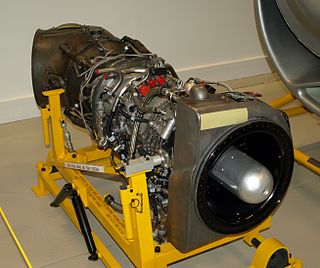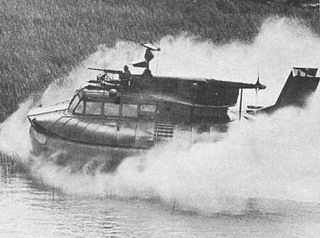Westland Aircraft was a British aircraft manufacturer located in Yeovil, Somerset. Formed as a separate company by separation from Petters Limited just before the start of the Second World War, Westland had been building aircraft since 1915. During the war the company produced a number of generally unsuccessful designs, but their Lysander would serve as an important liaison aircraft with the Royal Air Force. After the war the company focused on helicopters, and was merged with several other British firms to create Westland Helicopters in 1961.
Westland Helicopters was a British aircraft manufacturer. Originally Westland Aircraft, the company focused on helicopters after the Second World War. It was amalgamated with several other British firms in 1960 and 1961.

A hovercraft, also known as an air-cushion vehicle or ACV, is an amphibious craft capable of travelling over land, water, mud, ice, and other surfaces.

The SR.N4 hovercraft was a combined passenger and vehicle-carrying class of hovercraft. The type has the distinction of being the largest civil hovercraft to have ever been put into service.

The Bristol Proteus was the Bristol Engine Company's first mass-produced gas turbine engine design, a turboprop that delivered just over 4,000 hp (3,000 kW). The Proteus was a reverse-flow gas turbine. Because the second turbine drove no compressor stages, but only the propeller, this engine was classified as a free-turbine. It powered the Bristol Britannia airliner, small naval patrol craft, hovercraft and electrical generating sets. It was also used to power a land-speed record car, the Bluebird-Proteus CN7. After the merger of Bristol with Armstrong Siddeley the engine became the Bristol Siddeley Proteus, and later the Rolls-Royce Proteus. The Proteus was to have been superseded by the Bristol Orion which would have given a Britannia a 75% increase in power for cruising faster.

The Westland Wasp is a small 1960s British turbine powered, shipboard anti-submarine helicopter. Produced by Westland Helicopters, it came from the same P.531 programme as the British Army Westland Scout, and is based on the earlier piston-engined Saunders-Roe Skeeter. It fulfilled the requirement of the Royal Navy for a helicopter small enough to land on the deck of a frigate and carry a useful load of two homing torpedoes.
Saunders-Roe Limited, also known as Saro, was a British aero- and marine-engineering company based at Columbine Works, East Cowes, Isle of Wight.

British Hovercraft Corporation (BHC) was a British hovercraft manufacturer that designed and produced multiple types of vehicles for both commercial and civil purposes.
The Society of British Aerospace Companies, formerly Society of British Aircraft Constructors, known as SBAC, was the UK's national trade association representing companies supplying civil air transport, aerospace defence, homeland security and space. As of October 2009 SBAC merged with the Defence Manufacturers Association and the Association of Police and Public Security Suppliers to form the ADS Group.
Hovertravel is a ferry company operating from Southsea, Portsmouth to Ryde, Isle of Wight, UK. It is the only passenger hovercraft company currently operating in Britain since Hoverspeed stopped using its craft in favour of catamarans and subsequently ceased all ferry operations in 2005.

The Westland Scout is a light helicopter developed by Westland Helicopters. Developed from the Saro P.531, it served as a land-based general purpose military helicopter, sharing a common ancestor and numerous components with the naval-orientated Westland Wasp helicopter. The type's primary operator was the Army Air Corps of the British Army, which operated it in several conflict zones including Northern Ireland and the Falklands War.

The Rolls-Royce Gnome is a British turboshaft engine originally developed by the de Havilland Engine Company as a licence-built General Electric T58, an American mid-1950s design. The Gnome came to Rolls-Royce after their takeover of Bristol Siddeley in 1968, Bristol having absorbed de Havilland Engines Limited in 1961.

The Saunders-Roe SR.N1 was the first practical hovercraft. The concept has its origins in the work of British engineer and inventor Christopher Cockerell, who succeeded in convincing figures within the services and industry, including those within British manufacturer Saunders-Roe. Research was at one point supported by the Ministry of Defence; this was later provided by the National Research Development Corporation (NRDC), who had seen the potential posed by such a craft.
Seaspeed was a British hovercraft operator which ran services in the Solent and English Channel between 1965 and 1981, when it merged with a rival to form Hoverspeed.

Hoverlloyd operated a cross-Channel hovercraft service between Ramsgate, England and Calais, France.

The Saunders-Roe SR.N6 hovercraft was essentially a larger version of the earlier SR.N5 series. It incorporated several features that resulted in the type becoming one of most produced and commercially successful hovercraft designs in the world.

The British Hovercraft Corporation AP1-88 is a medium-size hovercraft. In a civil configuration, the hovercraft can seat a maximum of 101 passengers, while as a troop carrier, it can transport up to 90 troops. When operated as a military logistics vehicle, the AP1-88 can carry a pair of Land Rovers, a Bv202 tracked vehicle and trailer unit or up to roughly 10 tons (10,000 kg) of cargo.

The Saunders-Roe SR.N5 was a medium-sized hovercraft which first flew in 1964. It has the distinction of being the first production-built hovercraft in the world.

The British Hovercraft Corporation BH.7 was a medium size hovercraft. It was the first quantity-production hovercraft to be specifically developed for military applications.
Dr. Richard (Dick) Stanton-Jones D.Sc(Hon), FEng, M.A., M.Sc., CEng. was an English aeronautical engineer, chief designer Saunders-Roe, managing director of British Hovercraft Corp. and vice-chairman of Westland Helicopters.













